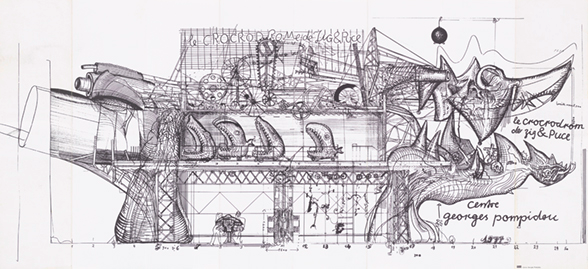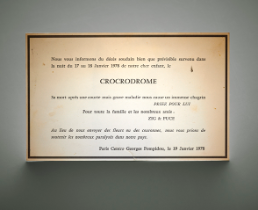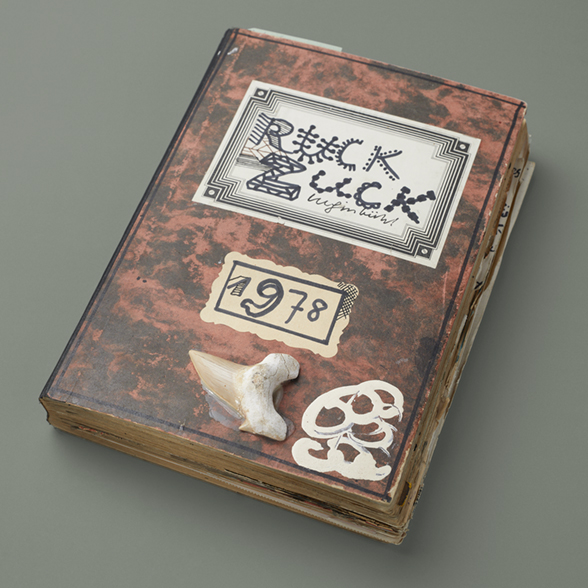The enormous installation entitled “Le Crocrodrome de Zig et Puce” was only on display for six months in Paris's newly-opened Centre Pompidou in 1977 before it was destroyed. In notes and diary entries, Bernese iron sculptor Bernhard Luginbühl (1929–2011) talks about the building and demolition of the spectacular work – and about his friendships.
By Lisa Oberli
“so today we start the demolition of the Crocrodrome”, wrote Bernhard Luginbühl on 2 January 1978 in the new volume of his diary entitled “Ruckzuck Luginbühl”. A meticulous diarist throughout his career, he wrote in lower case and in curved schoolboy handwriting full of puns and boundless energy, about the demolition of the monumental sculpture “Le Crocrodrome de Zig et Puce”. Luginbühl's notebooks from 1977–78 also contain references to the birth and death of this gigantic, walk-in installation. From 1 June 1977, it was displayed in the entrance hall of the Centre Pompidou, and as a fairground-style attraction for all ages, it played a key part in the events to mark the opening of Paris's revolutionary new museum.
Collaboration
The work, which was 30 metres long and 10 metres wide, was the result of a collaboration. Luginbühl's close friend Jean Tinguely came up with the idea of the dragon-like monster structure. Under the pseudonym “Zig et Puce”, Tinguely, Bernhard Luginbühl, Niki de Saint Phalle, Daniel Spoerri and their assistants contributed independent sections of the work. The building and demolition of the “Crocrodrome” were presented as constant works in progress by the participating artists who often collaborated.

© Luginbühl community of heirs / Centre Pompidou Paris
Niki de Saint Phalle created the jagged dragon head with jaws that opened and closed. Jean Tinguely designed a number of sections, including the stomach with built-in ghost train and the back with machinery, rods and coloured, flashing neon lettering. On one of the sides, Daniel Spoerri set up his “Musée sentimental” and in front the “Boutique aberrante” kiosk. Meanwhile, Bernhard Luginbühl designed the rear section with rusty iron plates and moving pipes. He even had one hind leg covered in chocolate and placed his “Tell Flipper” pinball machine between the feet. The construction work started in March 1977. On 1 June, the day of the opening, the “Crocrodrome” was still unfinished. It continued to be a work in progress until it was dismantled in January 1978. The work was the result of a lively exchange between the artists involved – and Bernhard Luginbühl was at the heart of it all welding, drawing and writing.
Crocrodrome notes
Already in early 1977 Luginbühl filled two notebooks with “Crocrodrome notes”. Both start with critical remarks about the Centre Pompidou building project. The Centre was built on the site of the former Les Halles market and a seedy lorry park, and Luginbühl felt that the museum stood on the ruins of a whole neighbourhood. He wrote: "the scale of the destruction of a whole Parisian neighbourhood opened up a sacrificial hole, so this gigantic hole was made into the basement of the largest modern art museum of our time". Nevertheless, Luginbühl enthusiastically participated in the “Crocrodrome” and even recycled construction waste from the new museum building in his design.

© Luginbühl community of heirs
In early 1977, after visiting the newly-opened museum with the founding director, Pontus Hultén, he noted: "for our CROCRODROME we can inherit iron from a previous exhibition – one millimetre-thick rusty iron, like the construction waste from the building of the new museum." From April 1977, Luginbühl then developed more precise building plans for the “Crocrodrome” which he shared with “Jeano” (Jean Tinguely): "I can't stop thinking about getting to work on that metal," adding what grid system he was planning and how he planned to rivet and weld the metal.
Farewell to the Crocrodrome

© Centre Pompidou Paris
After a year of planning, construction and exhibition, in January 1978 the time had come for the work to be demolished. Luginbühl describes in detail how, with his wife and child, and always with his friends “Jeano” and Daniel Spoerri in tow, he travelled to the Centre Pompidou in Paris on 2 January to start the demolition work together with their assistants: "demolition of the crocrodrome, sepp (one of the assistants) went crazy breaking up iron, dismantling the mechanisms […]". On 4 January the “Crocrodrome” slumped to the ground and the work could proceed, "[…] despite protests from museum staff, bits of iron frequently crashed onto the sacred concrete floor of the museum." On the same day, Jean Tinguely fell off the structure as it collapsed and had to quit, his face aching with pain. On 6 January, Luginbühl's "[…] metal rear of the CROCRODROME […] was attacked, and the big pipes came crashing to the ground, a sound that jeano could hear clearly on the other end of the phone as ursi called him from the museum to update him on the demolition of his back." The definitive end of the Crocrodrome was marked by an obituary notice dated 19 January 1978.
The notes and diary entries on the “Crocrodrome” are short passages in the extensive artist's books and diaries that Bernhard Luginbühl kept throughout his life. The unique volumes are very valuable for research into Luginbühl's own work and that of his artist friends. The diaries have been preserved in the Prints and Drawings Department at the NL since 2019.
Bernhard Luginbühl (1929–2011) taught himself iron sculpture in 1949, before working as an iron sculptor, performance artist, illustrator and graphic artist and presenting his work at numerous national and international exhibitions. From the early days of his career right up to his death in 2011, he kept a series of artist's books and diaries – largely in secret – in which he reflected on his own work, art, food and friendship.
Bibliography and sources
- Leonardo Bezzola: Das “Crocrodrome”. Eine Bildreportage von Leonardo Bezzola, in: Werk – Archithese: Zeitschrift und Schriftenreihe für Architektur und Kunst, vol. 64, 1977, No. 9, p. 18–19.
- Jochen Hesse: Der populäre Künstler. Das Beispiel Bernhard Luginbühl, Bern et al.: Peter Lang, 2008 (European University Studies, series 28, volume 431).
- Jochen Hesse: Bernhard Luginbühl. Werkkatalog der Plastiken, 1947-2002, Zurich: Verlag Scheidegger & Spiess, 2003, p. 490 and No. 1287.
- Bernhard Luginbühl (Ed.): JT. Tagebuchnotizen von Bernhard Luginbühl oder ein Rezept für Zwiebelfischsuppe, Basel: Museum Jean Tinguely / Bern: Benteli, 1997.
- Diary “Ruckzuck Luginbühl” (1978) in HelveticArchives
- Notes on the Crocrodrome in HelveticArchives.
- Crocodromenotizen in HelveticArchives
Last modification 15.06.2023
Contact
Swiss National Library
Prints and Drawings Department
Hallwylstrasse 15
3003
Bern
Switzerland
Phone
+41 58 462 89 71








